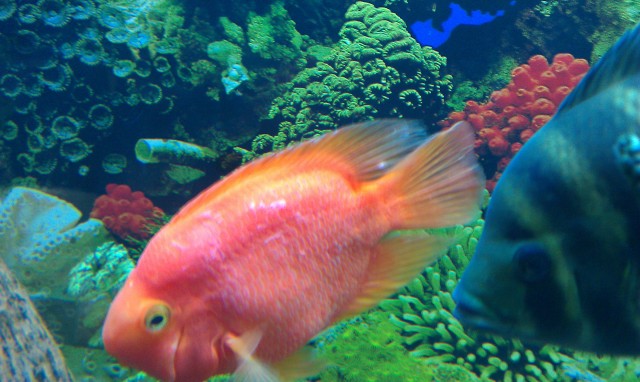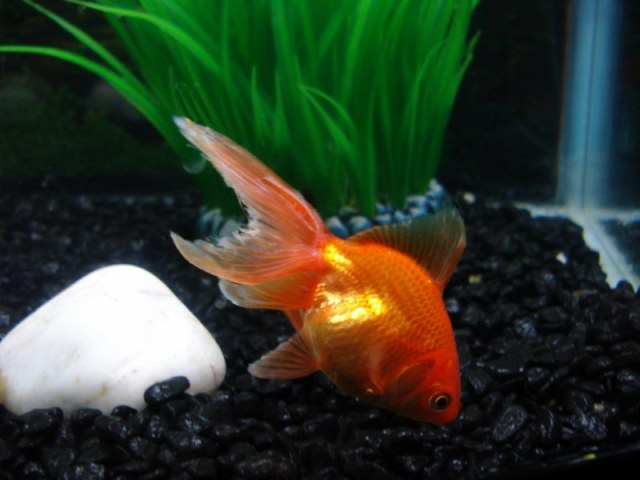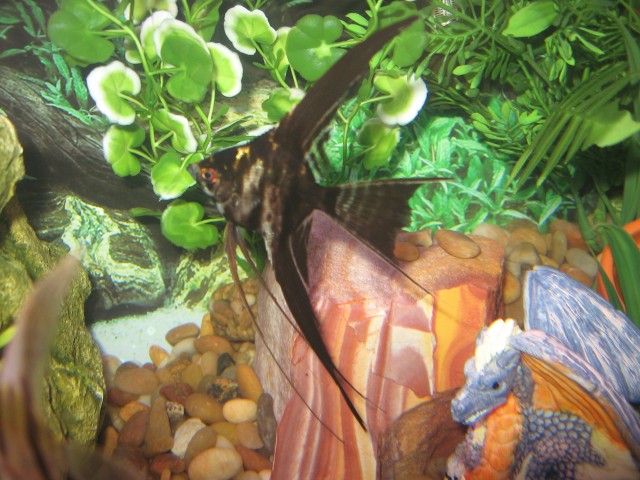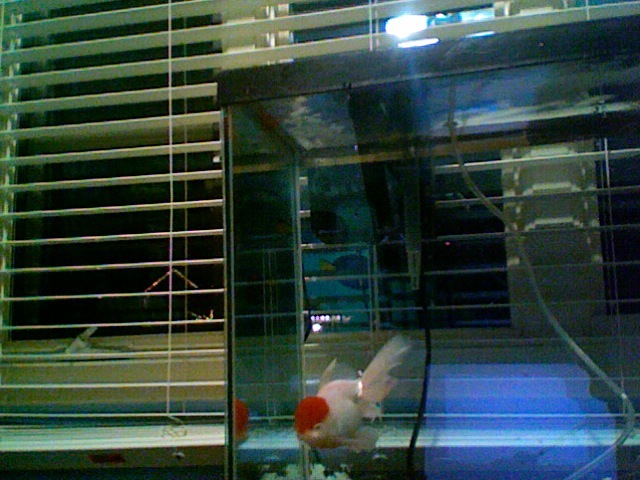Question-------------------------
Followup To
Question -
Hi Chris!
First, thank you for answering my question last week in such a timely fashion. I was getting kind of nervous. There is so much conflicting information out there, it's wonderful to get help from someone that truely has been there, done that.
My question is... In the area we live, the water is heavy with iron, quite hard and alkaline (8.2). We have well water, but I still use water conditioner because it "claims" to also remove heavy metals from the water. On my plants and on the glass of the aquarium I am starting to get brown spots. Is this algae or discoloring from iron? From what I have seen, iron will accumulate on any surface that our tap water has been allowed to sit, like in a water pitcher. Since this is my first aquarium, I do not know which it is, iron deposits or algae. What should I use if it is algae? Is there any chemical additive I can use to help get rid of the iron or is that something I don't really need to concern myself with?
Also, I have read that boiling your tap water prior to a water change will help reduce the hardness and alkalinity, is this true and if so, how long would I need to boil it?
Again, thank you for being so timely. It's nice to know I can get straight answers and fast. Have a great weekend!!!
Cathi
Answer -
Hi Cathi;
The brown stuff is probably just brown algae. If it wipes off easily that's what it is. Don't use chemicals to get rid of it. Just make water changes more often and don't overfeed. Replace 25% of the water every week while vacuuming the gravel. The chemicals used for algae removal are actually a controlled amount of poison and just aren't good for the fish.
I don't know if boiling the water will remove much of the minerals but I think it does remove some. It sure sounds like a lot of trouble though. Another danger is you will be adding additional metals by heating the water in a metal pan. You could use glass, but dedicate the glass pot only for that use. Mineral deposits will collect in it and make it look pretty ugly. Remember that boiled water has little or no oxygen in it so don't make very large water changes at once. No more than 25% at a time. As the tank runs and aerates the water for a few minutes it will restore the oxygen. But, too much water without oxygen added at once may not get oxygenated in time to keep the fish alive.
What might be easier is to get some clean 5 gallon jugs and get water from someone else's tap if you can. Don't buy bottled drinking water to use though. I have been hearing that chemicals are added to kill bacteria and it has been killing fish. I don't know this for a fact, but I personally wouldn't take the chance until I find out for sure. Keep using the water conditioner. They do bind heavy metals and it reduces their effect on the fish. Hopefully it will help enough to keep from causing trouble in your tank.
If the fish are accustomed to the higher pH and hardness then you shouldn't worry about it anyway. It is more harmful to the fish to be subjected to fluctuations while you are trying to adjust it.
What size tank do you have and what kind of fish?
How long has it been set up?
Followups Welcome
At Your Service;
Chris Robbins
Come on over and join us on the freshwater fish forum at About.com to get even more information too;
http://freshaquarium.about.com/od/questionsanswers/a/naavigateforum.htm
My member name is ChrisR62. See You There!
Hi again Chris,
In answer to your questions, we have a 20 gallon tank. Our filtration is a penguin 170 bio-wheel and we are also aerating the water with an air stone. The tank temp hovers around 79 degrees. We set up our tank the first weekend of January and have gradually added six platys. Unfortunately, one of them had babies. So in total, we now have 13 fish in the tank. (a few of the fry escaped the breeders box and are now missing in action, opps) I am thinking about adding an under gravel filtration system to the tank, do you think this is overkill? Just want the fish to be healthy.
I test the water daily for ammonia, nitrates, nitrites, pH etc. and do 25% water changes every other day. I realize that this will slow down the cycling process, but I want to give the fry the best chance that I possibly can and I am waiting for the bio-filter to catch up to our overload. Maybe I should change the filter more frequently, Lord knows what is truely lurking in our well water. I changed the filter at four weeks, perhaps I'll try only going two weeks and see what happens.
I do have a question about under gravel filtration. Do you have to periodically tear down the tank to clean beneath the UGF? I am clueless! Giggle!
Thanks again for being to fast!!!
Have a good one!!!
Cathi
AnswerHi Cathi;
My article on new tanks will help you through this. The most important thing is to NOT change the filter! Every time you remove the filter you remove the beneficial bacteria with it. My article explains other ways to handle that too, so I will include a copy of it at the end of my letter.
I used to use UGF on all my tanks. I don't anymore though. They are just not worth it these days with the power filters and other options available. You could add an internal filter or an extra power filter to help your other one instead. On my 55 gallon I have a Fluval canister and a fluval internal as well as a bubble wand. It keeps the tank very nice. I rinse the media in them every 4 to 6 months. But, not at the same time. I wait a couple of weeks between filters so I don't stress the system too much. Treat the beneficial bacteria as if it is a fish. It can die and be stressed from disturbing it too much and it can't do it's job, so the fish get stressed from toxins building up.
**********
New Tank Syndrome or Break-in Period
So you have a new tank and you filled it up, put the filter together, mounted the heater into place and turned on the lights. You have all the plants and decorations where you want them....
You are ready for fish.
But, your filter is not ready for a full tank of fish yet.
The filter is running and moving the water and cleaning out crud, right? Of course!
But a very important part of your filter is the part you can't see. An aquarium filter removes the larger visible stuff, but it also must remove the dissolved fish waste that turns into ammonia in the water. To do this, special bacteria must grow in the filter system and on the particles of gravel in the bottom of your tank. This process occurs even on a limited scale in little fish bowls that have no filter in them.
This is "New-Tank Syndrome" or the "Break-in Period". The entire process takes 6 to 8 weeks to complete because these "nitrifying" bacteria grow quite slowly.
Start off with only one or two hardy fish (no more than 2 total inches of fish) for every ten gallons of water and don't add more until the 6 to 8 weeks has gone by. Hard to be patient, but it is worth it to keep your fish alive and healthy. As a matter of fact, the bacteria cannot develop without fish in the tank. You can let that tank sit forever without fish in it, but as soon as the first fish goes in the process begins. Avoid changing the filter pads during break-in. This removes the bacterial colonies that are essential to a balanced aquarium. You can rinse the filter pad out in a container of aquarium water. This will preserve most of the bacteria colonies while still allowing your filter to flow freely. Even using bacteria additives and water conditioners when you first set up the tank will not make a tank begin the cycle by itself. If there are no fish to provide food (fish waste) for the bacteria, the beneficial bacteria cultures will die and you will have to start the colonies all over again once fish are added to the tank. Once the tank has completed the initial cycle, you can change the filter pads every 4 weeks or so. But for now, just rinse them.
Feed your new fish VERY lightly. Any excess food will cause additional waste your system cannot afford to have right now. If you see food floating around or lying on the plants and gravel after five minutes, too much food is going into the tank. Cut back a little each time you feed until it is ALL gone 5 minutes after you feed them. Feed them once a day.
During this "break-in period" your tank will become cloudy and milky looking. You may have to tolerate this for the entire break-in period but it is only temporary. Changing 25% of the water three times a week until the break-in period is over helps a great deal. Changing water reduces the ammonia and nitrites that rise while the bacteria continues to multiply. If ammonia and/or nitrites become too high, your fish will become stressed and possibly die. Use a good water conditioner when you replace the water and make sure it is the right temperature to avoid shocking your fish.
When the break-in is over after 6 to 8 weeks and there are no nitrites or ammonia present in the water you can slowly add more fish. Add one or two every week until you reach the desired population. This allows the bacteria to adjust to the new population every time before adding more. Monitor the nitrites and ammonia to be sure they don't come up. If they do, make a 25% water change and check them again. Don't add the next fish until the levels are down again.
The safe maximum population for any size tank is one inch of adult fish for every gallon of water in the tank. Do some research to be sure of the fish you are interested in. Even though they are small when you buy them, you have to base your population calculations on full-sized adult fish. Many hobbyists have up to two inches per gallon but this can be risky. If a water quality issue arises or a disease occurs it will spread fast and furious in an over-populated tank. In any case, 25% water changes every week to two weeks are absolutely essential for the health of your fish.
Following these guidelines will help you get your new tank on the right track.
**********
Followups Welcome
At Your Service;
Chris Robbins
Come on over and join us on the freshwater fish forum at About.com to get even more information too;
http://freshaquarium.about.com/od/questionsanswers/a/naavigateforum.htm
My member name is ChrisR62. See You There!

 Parrot disease
Question
scales peeling off
I have a 115 gallon tank wi
Parrot disease
Question
scales peeling off
I have a 115 gallon tank wi
 Goldfish - tank move - fin rot
Question
Professor the fantail
Hi,
I was given three f
Goldfish - tank move - fin rot
Question
Professor the fantail
Hi,
I was given three f
 Room for more?
QuestionQUESTION: I got a little carried away last nigh
Room for more?
QuestionQUESTION: I got a little carried away last nigh
 My new Oranda
Questionoranda
QUESTION: My new Oranda has Red S
My new Oranda
Questionoranda
QUESTION: My new Oranda has Red S
 white spot or not
QuestionQUESTION: hi nathan.i have a juwel vision 450li
white spot or not
QuestionQUESTION: hi nathan.i have a juwel vision 450li